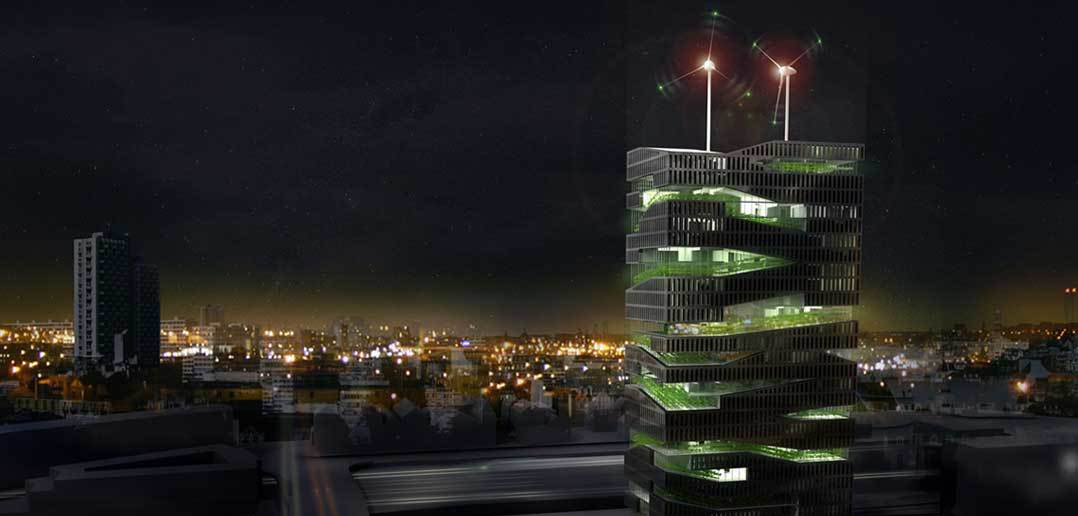Chris Jacobs had not even a fleeting idea of what a vertical farm was when it was pitched to him. But the idea was among the concepts presented to his online marketing and communications company, United Future, for a campaign featuring technologically innovative concepts that would promote alternative energies.
Intrigued, Jacobs spent a solid six hours designing an ad containing one of these structures, a tower bursting with emerald life. Once he was finished pouring over his dual-computer system of a Mac and a PC, he spent the next week passing his architectural design around to various friends and colleagues. One gave the design three-dimensional life while another added rendering to offer the final touch of realism. Proud and excited over the finished product, Jacobs’s ad was incorporated into the marketing campaign of his client, a multinational design software corporation. But an internal shift of management occurred and Jacobs’s ad was dropped.
“I couldn’t let that happen! I found the [scientist]who created the idea and I called him up.” Chris Jacob’s single phone call carried him from his air-conditioned office in L.A. all the way across the country to the academic halls of Columbia University where he rang the office of Dr. Dickson Despommier, who has devoted himself to the project for over ten years. Jacobs offered introductions to Despommier and then hastily urged him to check his email. A few minutes passed until Despommier exclaimed excitement: “You did it!” At that moment, Jacobs knew he had crafted the first true design of an actual vertical farm.
A DESIGNER’S GROWTH
The environmental movement was never a major motivation in Chris Jacobs’s life. “I have to admit, I was never really a green-driven person,” he said. Born and raised in Los Angeles, CA, he originally dropped out of high school, but later decided to finish his basic education at a local junior college. Afterwards, however, he was faced with the toiling question of what to do next with his life.
The prospect of flight filled him with excitement, so he attended the Jet Copters Helicopter School in hopes of later joining the LAPD. In addition, he also worked fulltime as a professional by-hand drafter for an architect. As time passed, Jacobs realized he had to make a solid choice of where to take his life, and since he was in competition with ex-military personnel to pilot choppers for the LAPD, he decided to devote himself fulltime to his creative abilities.
He first began his higher education at the Woodbury University of Architecture in Burbank, CA, during 1989, but after two and a half years of hard work he discovered he had a severe allergy towards certain glues used in creating architectural models. To make matters worse, he was also consistently reminded by guest speakers at the university that the future of young architects was bleak in the then failing economy of the late eighties and early nineties. “[I] was being reminded… that architects were driving cabs to make money because of the economy at the time.”
Jacobs decided that another change was in order, causing him to transfer in 1991 to the Art Center College of Design in Pasadena, CA. While there, he completely shifted his academic focus onto graphics and computer design, a love that had been growing in him since he was a teenager. His passion and enthusiasm for technology made his education a delight and he graduated with honors in 1995.
After graduation, Jacobs’s lived his life with vigor and ferocity. He started an interactive media company right out of college with his friend, Kent Campbell. The enterprise began with only the two of them in a small office space, but the pair eventually grew the company within five years to having over 40 employees in two countries. Their venture became such a success that they sold the company in 1999 for $10 million in stock. Within six months of the sale, Jacob’s net worth skyrocketed to an estimated $6.6 million. But his fortunes were short-lived, as the stock market crash in 2000 wiped out his entire net worth. “I lost it all… [and I]ended up more in dept than with actual positive cash.”
But even with his losses, Jacobs never admitted defeat and built himself back up over the years. He’s moved around in various positions, some of them taking him all the way to Hong Kong and Singapore for extended periods of time. The entrepreneurial spirit never left his heart though, and Jacobs again settled himself in California where he sought out an old friend, Scott Holmes, from his first company with the proposition of starting a new one. The two combined their efforts with Kris Matheney and Steve Karr and forged their current company, United Future.
GREEN BEGINNINGS
After his ad was returned to him and he offered it to Despommier, Chris Jacobs’s career took a turn he never expected. Despommier proceeded to post the designs from the ad on the official vertical farming Web site for the public to see.
Among those enticed by his designs was Lisa Chamberlain, a writer for New York magazine. She originally contacted Despommier about writing an article covering vertical farming, but he directed her to Jacobs, who soon turned into the unofficial media contact for the project. “I knew that in order to do this properly, I had to fly to New York City and meet with [Despommier] and get the scoop on all the technologies that surround a successful vertical farm.” After flying across the country to the Big Apple and arriving at Columbia, he was given a crash course in all things vertical farming.
Primarily, an agricultural shift towards vertical farming, away from traditional horizontal field farming, would have a twofold affect: controlled crop production and reforestation. Food production would fall completely under human control as all farming would be relocated indoors within controlled environments, preventing crop failure, eliminating pesticide and fertilizer usage, allowing for direct distribution of harvests, and permitting year-round production. And with farmlands no longer needed for crop production, countless acres could be reforested, restoring untold amounts of hardwood forestry to temperate and tropical areas. “The re-growth of hardwood forests could play a significant role in carbon sequestration and may help reverse the current trends in global climate change,” Despommier wrote in an essay on vertical farming.
Chris Jacobs personally feels that distribution is a key factor that makes the concept so enticing. “[Vertical farming] would make any city an instant urban agricultural leader,” he said. He notes that by introducing vertical farming into an urban setting, such as New York City, freshly produced food would be readily available from the point of harvesting, allowing it to be directly distributed throughout the city and ultimately creating a fresh and sustainable source of nourishment.
These towers would house several levels of growth, from livestock to fruits and vegetables. Hydroponics, the system of growing plant-life in water rich with mineral nutrients totally without the use of soil, would play an important role in the vertical farming process. Jacobs also points out that the United States already thrives greatly on hydroponics, saying that, “Most people don’t realize that the wonderful vine-ripened tomatoes they buy at the market are most likely grown hydroponically.” Using hydroponics for a large-scale effort would completely eliminate the need for both fertilizers and pesticides, and with them gone, so goes the contaminated runoff they produce. “[Also], there is a drastic increase of the amount of food per acre (200% to 300%) with hydroponics… and [it]only uses 10% of water used in dirt-farming,” Chris Jacobs added.
It’s also important that vertical farms imitate natural functions in order to create a sustainable system of growth. A large part of this is “mimicking the ecological process;” a kind of natural recycling. Despommier wrote that vertical farms must recycle “everything organic, [as well as]used water—human and animal waste—turning it back into drinking water.” In fact, vertical farms can potentially create a completely new source of fresh water. “[Vertical farms would convert] black and gray water into potable water by engineering the collection of the water realized through evapotranspiration,” Despommier wrote.
Supplying power to one of these behemoth buildings is not something out of reach, either. Despommier believes that several different energy outlets could successfully power a vertical farm. He considers wind power, solar energy, tidal power, and biogas production all as viable outlets of energy. Jacobs also recognizes the vast potential in a wide variety of cutting-edge technologies, such as Maglev wind turbines.
Aside from supplying power to a vertical farm, they in turn would save a great deal of power in the form of fossil fuels, drastically reducing fuel emissions in a variety of ways. “[Vertical Farming] will eliminate forever the need for burning fossil fuels during the act of farming… and the need to deliver them to the consumer,” Despommier wrote.
Since Chris Jacobs’s preparation for the initial article proposed by Chamberlain for New York magazine, the media has snatched up the concept. Several stories on vertical farming have appeared in a variety of outlets, including Plenty, U.S. News, CNN Money, Wired Science, Science magazine, The Huffington Post, the New York Times, and The Colbert Report. But it was that one article for New York magazine that started all of the excitement, in Jacobs’s opinion. “[That] article started all of the hype. It was the catalyst that eventually… spawned all other vertical farm designs and articles.”
IMAGINATION VS. REALITY
Aside from innovation and promise, a single question will arise about vertical farming that will either propel the project forward or halt it cold: How realistic are these things?
To erect one of these buildings, one kind of green is going to be needed for the other kind, and a lot of it. It’s been estimated that a single vertical farm tower could cost upwards of $200 million. Because of the steep price tag, both Chris Jacobs and Dickson Despommier agree that public subsidies would only go so far and that eventually the agricultural advent would have to move over into the private sector. Jacobs believes that by offering companies enticing tax incentives, it’s a strong possibility. “But I think these incentives should really be more for taking the risk to create something so ground-breaking—something that feeds the neighborhood, cuts down on [carbon], and localizes food production,” he said.
The concept may seem unruly upon initial consideration, but Despommier offered enticing statistics that makes vertical farming seem more than reasonable. “Our group has determined that a single vertical farm with an architectural footprint of one square New York City block and rising just 30 stories (approximately 3 million square feet) could provide enough calories (2,000 cal/day/person) to comfortably accommodate the needs of 50,000 people, and mainly by employing technologies currently available,” he wrote.
Chris Jacobs personally believes that something else will rise up out of the advent of vertical farming: “verticulture.” He feels that whole new cultural innovations could be spawned from vertical farming, primarily new forms of employment that could give the economy a strong boost. In fact, he feels that the tax incentives offered to companies for vertical farming should only be for those that employ American citizens and don’t attempt to ship jobs overseas. Those employment opportunities could also expand into a form of tourism, offering another outlet of revenue.
Jacobs is thinking so far ahead that he’s even considering the possibility of adding apartments onto the upper levels of a farm as well as markets in the lower levels. Such a concept is still very much in its infancy, but it’s something he’s experimenting with in his current architectural models.
But ultimately, no matter how innovative the concept is, it would require a titanic overhaul of America to move from the fields into buildings. But Chris Jacobs thinks it’s ridiculous to consider the shift towards vertical farming as an overnight venture. He believes that proper education, publicity, and marketing would do the concept wonders, eventually moving the idea forward to a day when a condemned building in New York City could be torn down and replaced by a lush and thriving green tower. “[Ultimately], I believe that city-dwellers will welcome something this radical and innovative, because, really, they don’t see anything else coming close to delivering like this. Do you?”
This article originally appeared on Green & Save News.




